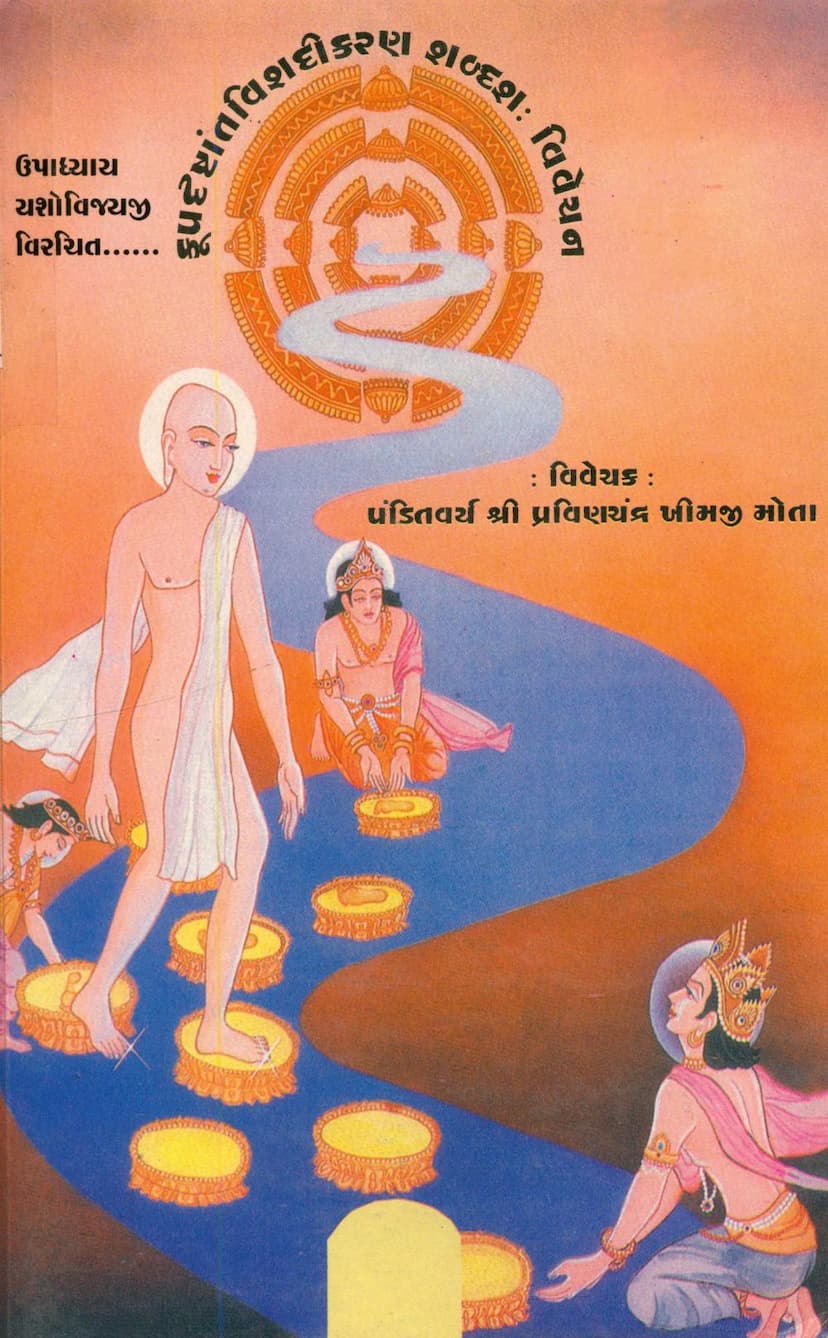Kupdrushtant Vishadikaran
Added to library: September 2, 2025

Summary
Here's a comprehensive summary of the Jain text "Kupdrushtant Vishadikaran" by Pravin K Mota, based on the provided pages:
Book Title: Kupdrushtant Vishadikaran (कूपदृष्टान्तविशदीकरण) Author: Upadhyaya Yashovijayji (मूल ग्रंथकार तथा टीकाकार: न्यायाचार्य-न्यायविशारद महोपाध्याय श्रीमद् यशोविजयजी महाराजा) Commentator/Analyst: Pandit Pravin Chandra Khimji Mota (विवेकनकार: पंडितवर्यश्री प्रवीणचंद्र खीमजी मोता) Publisher: Gitarth Ganga (प्रकाशक: Gitarth Ganga)
Core Subject:
The central theme of this text is to clarify and explain the "Kupdrushtant" (Well Analogy) used in Jain scriptures, particularly in relation to the worship of deities (Jina Puja) and devotional practices (Dravya Stava). The book aims to resolve apparent contradictions and establish the purity and efficacy of these practices, even when seemingly involving harm or ritualistic imperfections.
Key Arguments and Explanations:
The text, primarily a commentary on Yashovijayji's work, delves into the nuances of the Kupdrushtant, asserting that:
-
The Kupdrushtant Explained: The analogy of digging a well is explained in two ways:
- Pure Ritual Worship (Vidhi-shuddha Puja): Just as digging a well eventually yields pure water that benefits both oneself and others, pure ritual worship leads to self and societal benefit.
- Impure Ritual Worship (Vidhi-ashuddha Puja): When digging a well, one initially gets dirty with mud and experiences hardship, but later the water cleanses and quenches thirst. Similarly, even worship that might have some initial ritualistic flaws can lead to purification and benefit through the associated devotional sentiment.
-
Reconciling Scriptural Views: The book addresses the criticisms and differing interpretations regarding the Kupdrushtant, particularly those by Acharya Abhaydev Suri. It meticulously argues that:
- Abhaydev Suri's criticisms primarily apply to worship that is deficient in ritualistic purity (Vidhi-virahita).
- Yashovijayji, through his commentary, establishes that the Kupdrushtant is fully compatible with pure ritual worship, and Abhaydev Suri himself acknowledged this.
- The text uses verses from various scriptures, including the Pratima Shatak, Bhagwati Sutra, Brihat Kalpa Bhashya, and Nishith Bhashya, to support its arguments.
-
Dravya Stava and Rituals: The text clarifies the nature of Dravya Stava (materialistic worship) and Bhava Stava (devotional sentiment). It argues that:
- Even rituals involving the use of materials like flowers (Pushpa) are considered Dravya Stava.
- The debate revolves around whether these rituals, which might involve harm to minute organisms, lead to karma bondage.
-
Karma Bandha and Nirjara: A significant portion of the commentary focuses on explaining how karma bondage and liberation (nirjara) occur, especially in the context of devotional acts.
- The text distinguishes between karma bandha (karma bondage) and nirjara (liberation).
- It explains that the intent and devotional sentiment (bhava) are crucial. Even if there's an unavoidable minor harm (e.g., to microscopic beings in flowers), if the underlying sentiment is pure and the ritual is performed with devotion and adherence to essential principles, it can lead to punya bandha (meritorious karma) and nirjara.
- The text emphasizes that pramada (carelessness) and anabhoga (lack of awareness) are key factors in karma bandha, whereas yatna (diligence) and pure intent can mitigate or eliminate it.
-
Distinguishing between Pure and Impure Rituals: The book meticulously differentiates between:
- Pure Rituals: Performed with full knowledge of scriptures, adherence to prescribed actions (vidhi), and deep devotional sentiment (bhava), leading to minimal or no karma bondage and significant nirjara.
- Impure Rituals: Lacking complete adherence to vidhi or bhakti, or performed with pramada and anabhoga, which can lead to some karma bondage, though potentially mitigated by devotional fervor.
-
The Role of Intent (Adhyavasaya): The commentator, Pravin K Mota, highlights that the underlying adhyavasaya (mental disposition/intention) is paramount. A sincere devotional intention, even with minor ritualistic deficiencies, is considered meritorious and can lead to nirjara.
-
The "Kupdrushtant" in Context: The Kupdrushtant is presented as an analogy to explain that initial actions might seem flawed or cause minor impurities (like mud from digging a well), but the ultimate outcome, driven by the core intention and subsequent purification (like water from the well), is beneficial and pure in the context of spiritual progress.
-
Discussion on various concepts: The text also touches upon:
- Nayas (Perspectives): The interplay of Vyavahar Naya (conventional truth) and Nishchay Naya (ultimate truth).
- Types of Karma: Discussing categories like karkashvedaniya (painful karma) and akarkashvedaniya (pleasant karma), and their formation.
- Dhyaana (Meditation): The importance of focused devotion.
- Pranidhana (Devotional Focus/Prayer): The distinction between general devotion during Puja and specific prayers at the end of Chaitya Vandana.
- Tirthankarhood: The intention behind aspiring for Tirthankarhood, distinguishing between devotional aspiration and materialistic desire (nidana).
- Dhruvbandhi and Adhruvbandhi Karmas: Explaining the types of karmas that are bound invariably versus those that are not.
Overall Purpose:
The primary goal of "Kupdrushtant Vishadikaran" is to provide a clear, reasoned, and scripturally supported explanation of devotional practices within Jainism. It aims to empower the reader with a deeper understanding of the scriptures, dispel doubts about the efficacy of rituals, and encourage sincere devotional practices that lead to spiritual upliftment and liberation. The commentary by Pravin K Mota is dedicated to making these profound philosophical points accessible to the Jain community.